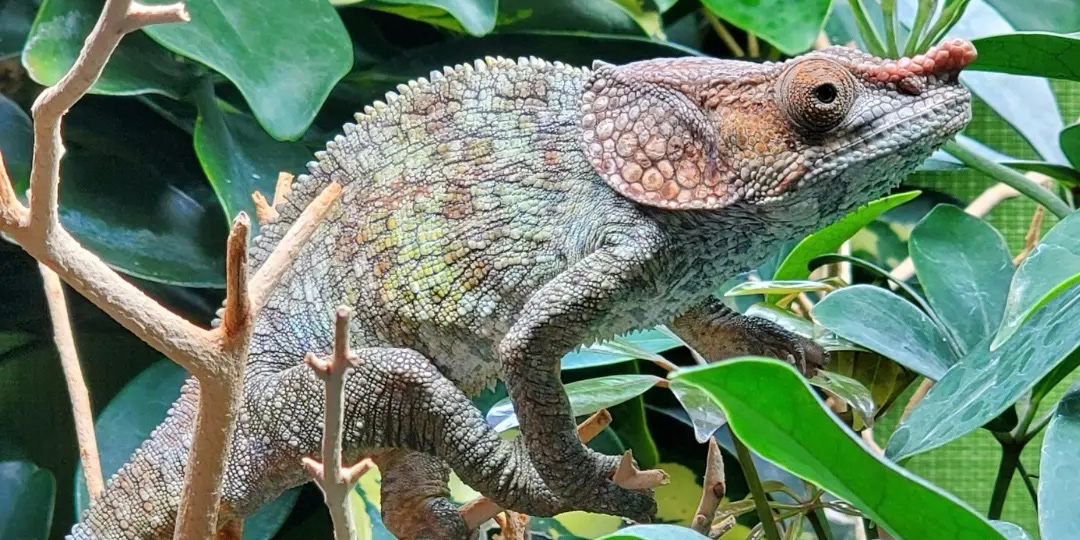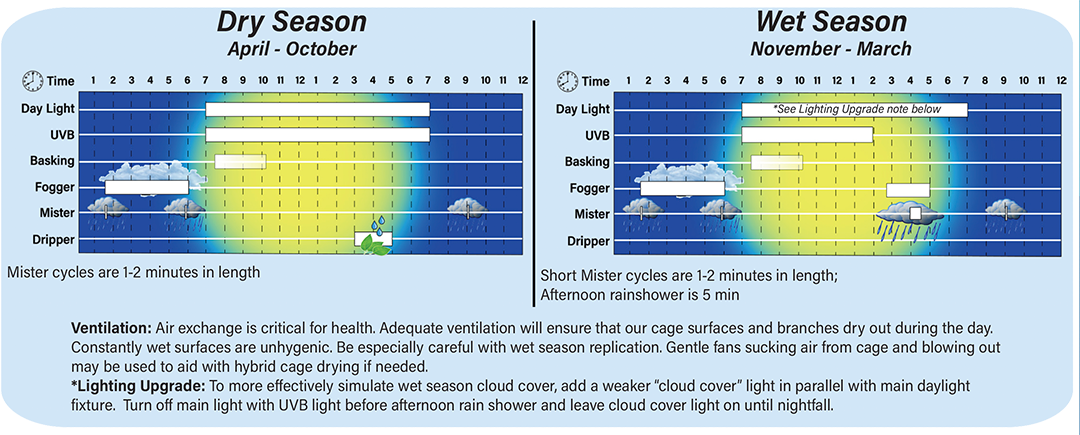Image courtesy of Steve Hefner
Introduction to Calumma brevicorne, the Short-Nosed Chameleon
Calumma brevicorne, commonly known as the Short-horned Chameleon, is an active, midsized chameleon from a wide range in Madagascar at elevations from around 810 to 1000m by the IUCN Redlist.
The most distinctive feature are a set of occipital lobes at the rear of their skull that they are able to flap when threatened or attempting to impress a female.
Calumma brevicorne has been exported in low numbers, but has been regularly available. But, despite this, they have flown under the radar for most chameleon keepers. But with their cryptic coloring, flapping lobes and strong personality, this hardy chameleon is a joy to work with.
The biggest challenge in reproducing this species to establish it in captivity is the apparent need for a diapause in incubation like many of the Calumma genus. And this requires a cooling incubator which are a problematic to find!
The ideal find would be a captive hatched individual, but the community is currently in the first round of serious breeding efforts so, hopefully, that is an option for a future day.
The Breeding Community

Image courtesy of Steve Hefner
The Calumma brevicorne chameleon has had a consistent availability to the chameleon community for the last many years, but has not been established. There are a number of breeders who are trying to change this and this care guide and details is part of that effort. Calumma brevicorne is a good species candidate for both breeding and single chameleon keeping. They are hardy and have a pleasant personality. At least as far as a chameleon goes! And so any breeding project will be able to place the offspring into the general chameleon community.
There has been spotty breeding, incubation, and hatchling success. Though there is no reason why this species shouldn’t be easy to reproduce. So we just need to figure out the tricks. At least at this point in time, it appears that incubation requires a diapause.
Calumma brevicorne Chameleon Pet Potential
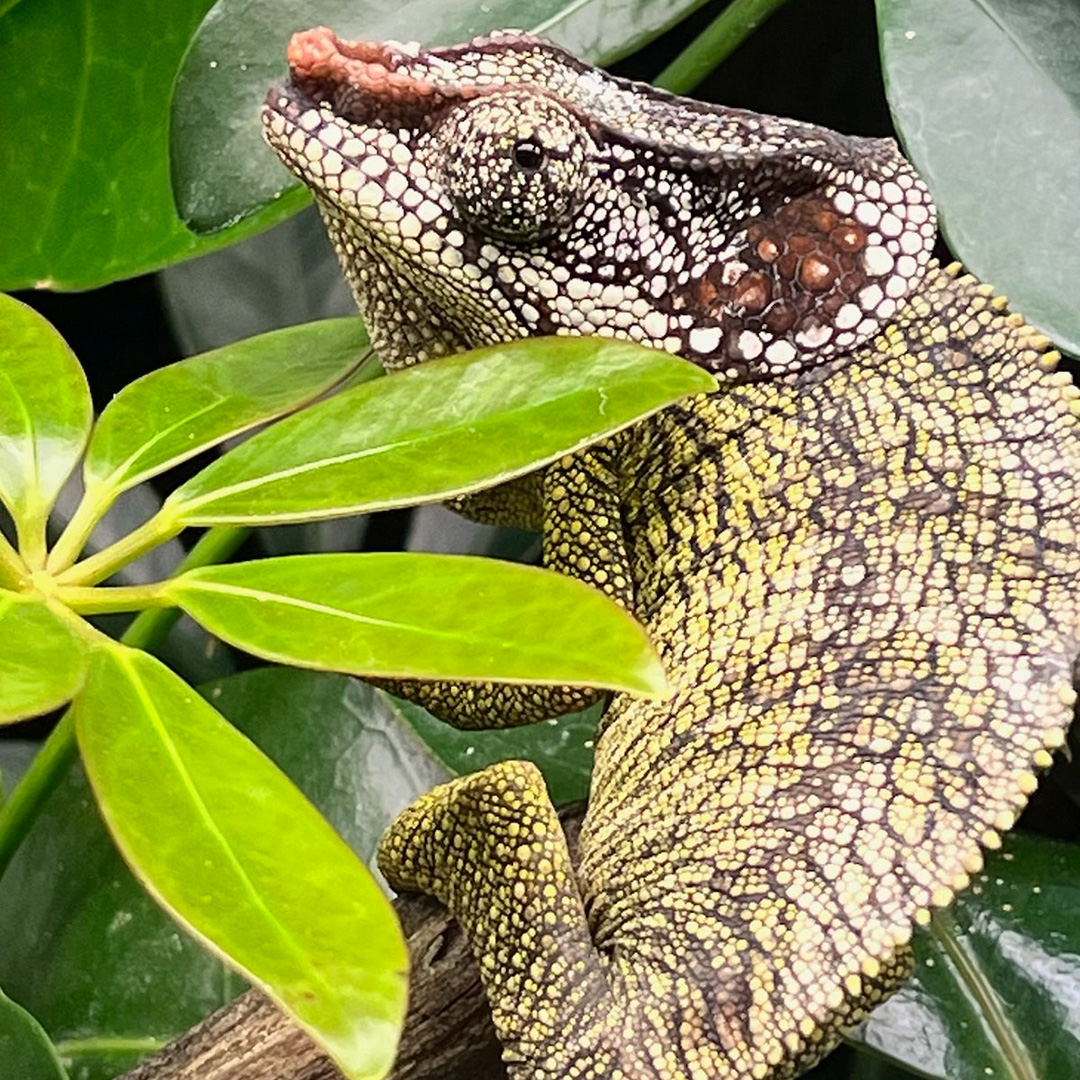
Image courtesy of Jay DuBay
For those interested in Calumma brevicorne as a pet or breeding project, the ideal situation is to buy captive hatched babies. That is a challenge at the time as the species is just starting to be bred. So people with experience acclimating wild caught specimens will be the bulk of the effort to begin with. But once those become successful there will be F1 babies available and this is where the wider community can start to become involved and purchase specimens for pets or F1 breeding groups. They are both critical for establishing a species in captivity!
At this time the best thing to do is to become part of the community and keep an eye out for availability. There is a grass-roots group started on Facebook where you can interact with the people working with this species. It can be found here The Calumma brevicorne Keepers Facebook Group
WARNING: Do NOT ask price on the Facebook group. Any mention or hint of sales of animals and Facebook can (and has) shut down the account without warning or recourse! So, when clutches are announced or hatched babies are posted, go to private messenger of the person posting the babies to inquire the following “I would like more information about becoming a Calumma brevicorne keeper. What would my next steps be?” And then you will be given directions for taking the next steps off of the Facebook platform. Even private messages on Facebook are monitored and can be used to shut a group down.
Calumma brevicorne Chameleon Care Summary
The Calumma brevicorne Care Summary distills the most important aspects of husbandry care into an easily referenced handout. But chameleon care is, unfortunately, much more involved than can be presented on a summary sheet. Therefore, you may use this sheet as a reference and return to this page where we will go over each and every aspect that is on the summary sheet in detail.
The Calumma brevicorne Chameleon Lifecycle
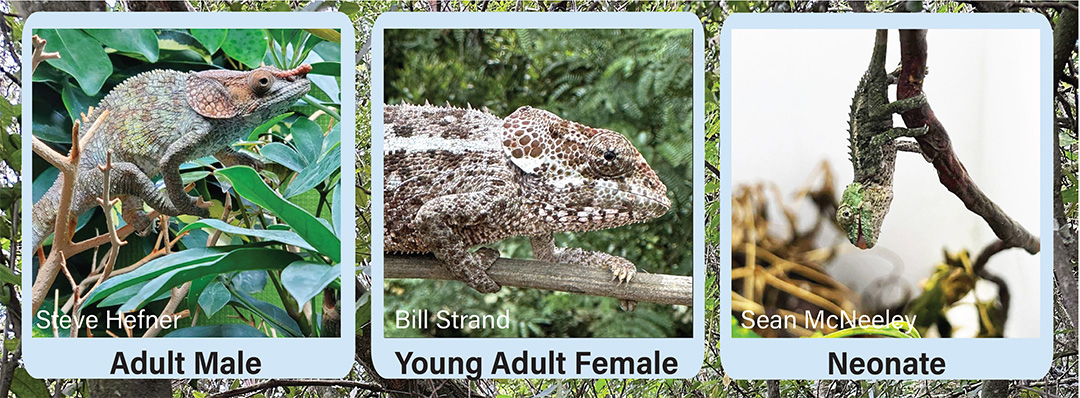
Cage Type, Size, and Set-up
Minimum cage size:
36″ x 18″ x 36″, 2′ x 2′ x 4′, or Greater
Cage Size.The Calumma brevicorne Chameleon is a mid-sized chameleon and the minimum cage size for both males and females that allows the creation of a suitable environment is 2’ x 2’ x 4’ tall.
Calumma brevicorne are housed in the Forest Edge style cage interior. A forest edge cage provides the open basking area and the densely leafy area where they can retreat, hide, and feel safe. This retreat area is critical for their well being. The most overlooked aspect of a chameleon cage is the visual retreat where the chameleon can hide away when they desire privacy. This is critical for creating an effective chameleon environment.
One chameleon per cage
One Chameleon per Cage. A time tested rule for chameleons is to house one per cage. The only time chameleons should be together is for mating and then the chameleons should go back to their own cages. It is human of us to want to pair things up or think of friendship, but chameleons are different. They have no concept of family or community in the way we think of it. Over the decades, newcomers test this over and over and the results always return back to one chameleon per cage. If you would like to dive deeper into the details of cohabitation and why it does not work in captivity (when they can be found around each other in the wild) then you may listen to these dynamics on this podcast episode: Ep 107 Keeping Chameleons Together
Screen, hybrid, or glass cages can be used depending on how much environmental control is needed
Cage Type.
The cage type (screen, hybrid, glass) depends on your environment. Take a look at the temperature and humidity requirements. How different are they from what the ambient conditions are in the room where the cage will be put? The further away from ideal you are, the more solid sides you will need on the cage. Combine that with the overwhelming success that keepers and breeders have had with bioactive hybrid cages that use the chimney effect for ventilation and a hybrid cage is the cage type that I suggest as a default choice.
A hybrid cage is one that has solid sides, back, and main door, with a screen top and some screen vents in the front that allow cool air to come in the bottom and rise to escape up top as warm air.
That said, if you have old screen cages lying around that you would like to use then simply block off the sides and back using coroplast panels or even shrink-fit window insulation.
You can start looking into hybrid cages with this podcast episode: Keeping Chameleons in Hybrid Cages
Ventilation.
It is important that there is air flow in the cage. But this means simply an exchange of air so the cage does not get stagnant. There is a common misconception that the cage needs to be all screen to get proper ventilation. In reality, an all-screen cage is usually too much ventilation and your ability to raise humidity is severely limited.
With the increasing use of hybrid cages the community must develop the skill of ensuring that there is the minimum ventilation. Once again, small vents at the bottom front and a screen top provide enough that there is a healthy air exchange.
You can test whether you have effective air exchange by how fast it takes for water misted onto the leaves to evaporate. There is no hard and fast rule. There just has to be moisture evaporating relatively soon afterwards.
Cage Interior
The cage should be densely planted to provide many hiding places for your chameleon. The top six to nine inches can be only sticks to provide easy basking with the heat bulb and soaking up UVB from the UVB light. But below that needs to be an area where they are able to feel secure and get away from the heat and UVB.
Calumma brevicorne has shown itself to make use of a densely planted cage where they can hide in the leaves.
MUST have suitable perching area behind plants where chameleon can hide entire body from view and block UVB light from above
Security. This is the most missed element of chameleon cage set-up. Your chameleon needs a feeling of security. They get this by having a dense plant layer in the middle of their cage. This leaf layer will need to be sufficient for them to perch with the majority of their body hidden away from view and it also must be dense enough to block the UVB from the UVB bulb above.
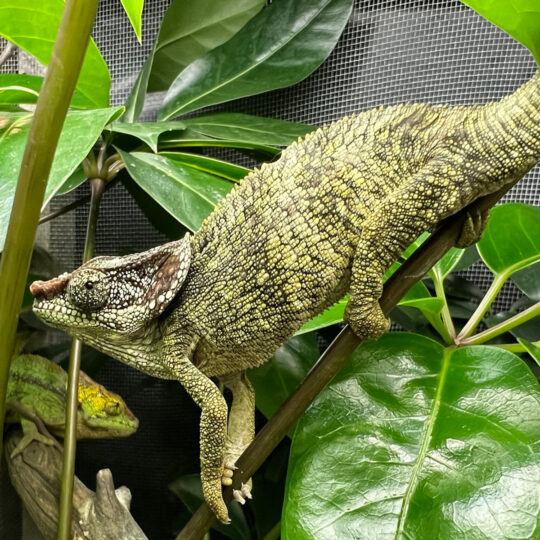
Calumma brevicorne will appreciate a well planted cage (Image courtesy of Jay DuBay)
Ambient Temperature
Summer:
Daytime: 75 °F / 24°C
Nighttime: 68°F / 20°C
Winter:
Daytime: 73°F / 23°C
Nighttime: 59°F / 15°C
Calumma brevicorne will do well in cooler, mid-70sF temperatures. Their natural environment will get up to 80F, and so, to create the necessary gradients we shoot for a cage around 75F and a basking bulb providing 80F at the basking branch.
This species does experience a wet and dry season and you can replicate this by taking the temperatures down a bit during the dry season months.
Basking Temperature
Basking Temperature: 80°F /27°C
Adults and babies have been raised under basking temperatures of 80F. Though Calumma brevicorne has not shown a great desire to bask in captivity. But it is important to provide a basking light for at least a couple hours in the morning as an option. The basking light may be turned off after a couple of hours of not being used.
For a basking light, either use smaller wattage bulbs or mount them a few inches away from the cage top, or both. You can use a thermometer to be your guide as to what you have to do. Resting the heat bulb directly on the cage top is usually a bad idea because the areas directly beneath the bulb, where a chameleon can climb upside down, will have excessive heat that can burn. Chameleons have, traditionally, been oblivious to when their own body is burning in the heat so we must take responsibility to ensure that any area they can conceivably reach has a safe temperature of the mid-80s F at most.
Humidity
Daytime: 40-50% RH
Nighttime: 80 – 100% RH
Calumma brevicorne will accept the standard naturalistic approach to humidity of upwards to 100% RH at night and then down to a level during the day that allows the surfaces of the cage and branches to dry out. The humidity numbers on the care summary of 40-50% give a magnitude that is likely to give you dry surfaces during the day without overly dehydrating the chameleon. And, this is where the numbers on the care sheet comes from. Humidity is part of the overall environment. The higher the humidity the less dehydrated the chameleon gets, but the more suitable for bacteria, fungal, and mold growth. The drier the climate the more the bacteria, fungal, and mold growth is inhibited, but the more the chameleon will dehydrate. Thus, the humidity cycle over 24 hours will be up to 100% during the cool night where we can hydrate our chameleon and the coolness slows bacteria growth. During the day when the heat and moisture would combine to make for a perfect bacteria growth environment, we take the humidity down just enough that the surfaces dry out. This is important because constantly wet surfaces will encourage bacterial/fungal/mold growth and produce sores on the feet of your chameleon. So, the drop in humidity during the day is less for the chameleon’s personal needs and more for the health of the overall environment that the chameleon depends on. With this 24 hour cycle repeated every day the chameleon stays hydrated while the cage environment stays healthy.
UVB

The most effective and reliable way to producing UVB for your chameleon is with linear T5 high output fluorescent tubes. These bulbs may go into a multi-bulb fixture, but are most effective in a single bulb reflector. I highly recommend using a single bulb reflector for your UVB source as it gives you not only the full power of the bulb (your UVB gets soaked up by other bulbs), but it gives you full control over the UVB strength that hits the basking area depending on how high you raise the fixture above the cage. But if a multi-bulb fixture is the only option then you simply get a high power UVB bulb.
Presently we are targeting an UV Index of 3 at the basking branch with a maximum of UVI 6 to allow for sufficient vitamin D3 synthesis. This is generally what you can generate using a T5 HO Arcadia 6% or Zoomed Reptisun 5.0 in a single bulb reflector at a basking branch 6″ inches from the light going through a standard screen cage top panel. If you are using a multi bulb fixture the rough estimate is to jump up to the 12% or 10.0. These numbers are all general estimates as each reflector will have it’s own reflection properties and each bulb will have different strength depending on age. Luckily, this does not have to be an exact value. Ballpark is fine!
But Calumma brevicorne is not much of a basker so do not expect to see much use of the UVB bulb. We must provide the option as that is where chameleons will get their vitamin D3, but do not get worried if you rarely see it being used. It is still doing a necessary job just by being there!
Setting up the lighting and hydration schedule
When we set up our daily schedule we are attempting to replicate the wild conditions that the chameleon has grown to expect. Let’s start at midnight.
At midnight the chameleon has been asleep for many hours. It is dark and, although the moon waxes and wanes, chameleons will seek out dark places to sleep. They see light of all colors just fine and any light can disturb their rest. This includes red light and other lights designed for reptiles. These lights do not fool chameleons. They recognize them as lights and it will disturb the chameleon’s sleep. Do not use any light at night.
As the early morning progresses the humidity rises. Fog banks can start to form and the chameleon is breathing in moist air. This high humidity forms an important part in their natural hydration. To simulate this, we turn ultrasonic humidifiers on around 1- 2AM. The fog from the humidifiers tends to bounce off of surfaces and roll out the cage so we run the misting system for a minute to coat the cage in a layer of water. This helps the fogger be more effective and the fog tends to stick around. The fogger is left on until just before the lights come on so the chameleon can breathe in all that humidity. Just before the lights come on the misters are run for another couple of minute to make sure that the chameleon wakes up to surfaces covered in “dew”. This is a natural source of water for them even in their dry season. Once the dew is laid down the lights can come on.
Around 7AM the daylights come on. This can include the UVB light if they are the same fixture. If they are separate fixtures then save turning the UVB light on to correspond to when the basking bulb is switched on. I like to leave the daylight bulbs on for 15 or so minutes to give the chameleon a chance to leisurely lick whatever dew they want. I then turn the basking bulb on so they can warm themselves up.
As the ambient temperatures start to warm there is no longer the need for a basking lamp and it is shut off. The actual time that the basking lamp is on will depend on your chameleon’s needs. Watch the behavior. If the routinely get the warmth they need in 30 minutes and then climb away with content colors to hunt then reduce your basking time to that time that they make use of the warmth. If they need the warmth for a longer period of time then leave the basking bulb on longer. Watch your chameleon and they will tell you what they need. With a screen cage there is usually no issue leaving it on for the day, but if your ambient daytime temperatures start getting to the high end of their comfort, you should shut the basking lamp off. In solid walled enclosures, heat may be retained and you will be able to shut the basking bulb off sooner. On my chart I am limiting the basking lamp to a couple hours. If your chameleon does not use the basking bulb at all then leave it on for just an hour in the morning to present the option.
Sometime during the day start your dripper. This is a backup hydration strategy just to make sure they have enough water. While it is true they do not have drippers every day in the wild during the dry season, they also are not needing to reconstitute dry calcium powder on all their feeders. The advantage of running a dripper is that it is completely optional for them and, as a bonus, it also allows you the opportunity to ensure your plants get watered. Place it above a different plant each day and through out the week, all plants will get watered. It is not critical when you start the dripper. In this schedule I have it in the late afternoon so that the chameleon can rehydrate before the evening rest. I suggest starting the dripper an hour or so after feeding them so they can replenish what they need. In the wild, their food is a source of hydration.
Once the chameleon settles in and goes to sleep I like to have a couple minutes misting just to set up the night humidity.
I am listing a template to safely replicate the wet and dry season transition. The basic change is that I add in a wet season rain shower in the afternoon. This will use a good dal of water and you do not have to do it every day. But note how it avoids the surprise blast of the mister by giving a warning by turning off the main lights and using the fogger to warn the chameleon that the clouds are rolling in. Your chameleon will learn that this means the misters will come on and will get out of their path.
Feeding & Supplementation

Calumma brevicorne are not picky eaters and should take in anything that moves and fits in their mouth. A good guide is to use feeder insects that are about one feeder unit where a single insect feeder unit is equal to the volume of a cricket that is the length between the eyes of the chameleon. Obviously, this can be variable, but it gives a safe magnitude. This means that, for example, if one feeder unit is a ½” cricket then that is equal to four ¼” crickets or 20 fruit flies or one ¾” or even 1” superworm. Just be mindful of the size prey that you offer so it does not hurt your chameleon by fighting back or choke them by being too big to swallow.
I recommend to feed adults 3-4 feeder units every other day. I am not aware of any particular dietary issues in this species so am giving basic chameleon dietary advice to avoid obesity.
Growing babies can be fed as much as they will eat
Introduction to Supplementation
The standard schedule of dusting with calcium every feeding and adding a multivitamin with Vitamin A and D3 of, at most, 100k IUs/lb of vitamin A every two weeks has been found to be effective and not cause edema.
| Manuf | Name | Vit D3 | Vit A | Mg | Ca:P | Carotenoids |
|---|---|---|---|---|---|---|
| Arcadia | RevitaliseD3 | 2.3k IU/lb | 23k IU/lb | 8% | No | Multi |
| Repashy | Calcium Plus LoD | 8k IU/lb | 80k IU/lb | No | No | Multi |
| Zoo Med | Reptivite w/ D3 | 10k IU/lb | 100k IU/lb | 2.7k mg/kg | 2:1 | No |
| Repashy | Calcium Plus | 20k IU/lb | 200k IU/lb | No | No | Multi |
Breeding Calumma brevicorne
We are still working out how to reliably breed and reproduce Calumma brevicorne. Though mating is quite simple. Introduce the female to the male and a mating communication will ensue. The male will do his best to impress her with dramatic color flashes and flapping occipital lobes. She will either accept his dance or reject him by gaping, flapping, or running. After a successful mating remove the female and put her in her own cage out of sight of the male. Gestation has been reported to be between 40 up to possibly 90 days. We need more data points to figure this one out. Eggs are laid in a standard egg laying bin. A 50/50 sand/soil mixture is my standard recommendation, but brevicorne have laid eggs in a variety of soil compositions. The species does not appear to be very picky. But give the female privacy when she shows signs of exploring the bottom of the cage as you want her to feel safe to spend hours digging a hole and laying eggs.
The female will lay 20-30 eggs and cover the hole up. Give her a week of pampering with water and food and she should bounce back.
The eggs appear to need a diapause, but I will be able to be much more confident in what they need when there are more successful hatchings. Incubation at 74F is about 11-13 months assuming a two month diapause at 55F near the beginning of the incubation period.
Babies are cared for like most chameleons. Keep them individually and beware of over powering them with heat and UVB. Age of sexual maturity is unknown, but we should be able to answer this within the next 12 to 18 months!


